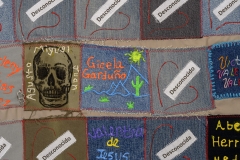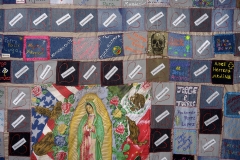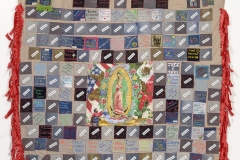Nancy Amann helped Jody Ipsen complete the Migrant Quilt for 2007−2008 from patches made a few years earlier by high school students in Douglas, a border town in southeastern Arizona. Library aides and students in Spanish language classes stitched the names with beautiful embroidery or wrote them with fabric paints, sometimes in a graffiti-like style. They embellished patches with buttons, fringe, braid and painted cactus, crosses and skulls. Amann completed the name patches and made all of the desconocido patches, which on this quilt far outnumbered the named ones.
One patch that Amann made incorporated a poignant photograph of Josseline Quinteros, a fourteen-year-old girl immortalized in Death of Josseline, an insightful book about the human side of the immigration crisis by Tucson author Margaret Regan. In January 2008, Josseline and her younger brother were traveling with a group from their town in El Salvador, on their way to San Diego to be reunited with their mother, when Josseline became sick and could not continue. The group’s coyote left her behind, assuring the teenager that the Border Patrol would find her, but that did not happen. Josseline had only the clothes she was wearing for protection from below-freezing nighttime temperatures, and she died alone in the Arizona borderlands. Three weeks later, a volunteer on patrol found her body after spotting her bright green tennis shoes in the desert.
As the quilt’s centerpiece, Amann used a bandana found in a child’s abandoned backpack, depicting the Virgin of Guadalupe flanked by flags of the United States and Mexico. An eighty-eight-year-old friend quilted the bandana onto a tan-colored sheet, and Nancy arranged the name and desconocido patches around it. To emphasize the meaning of the quilt, she placed patches below “Tucson Sector” containing the words “Broken Hearts/Broken Dreams/Broken Promises” and “The detritus/of the/Sonoran Desert.” Still not finished, she “wanted people to know the ages and cause of death to make their deaths more real,” so she created “prayer flags” from red ribbons, wrote the death information on them, and stitched the flags along the bottom and two sides of the quilt. Amann said:
I’m not a terrific quilter, just enthusiastic about the project. My hope was that anyone viewing the quilt would realize how many bodies weren’t found in time to identify them. All the parents, children, grandparents, lovers . . . who had no idea what happened to those people. I want people to understand that no matter how they feel about the problems of illegal immigration, the migrants are people. Like you and me. (from Peggy Hazard, “What the Eye Doesn’t See, Doesn’t Move the Heart: Migrant Quilts of Southern Arizona,” in Uncoverings 2016, ed. Lynne Zacek Bassett (Lincoln, NE: American Quilt Study Group, 2016), 29-31.)


